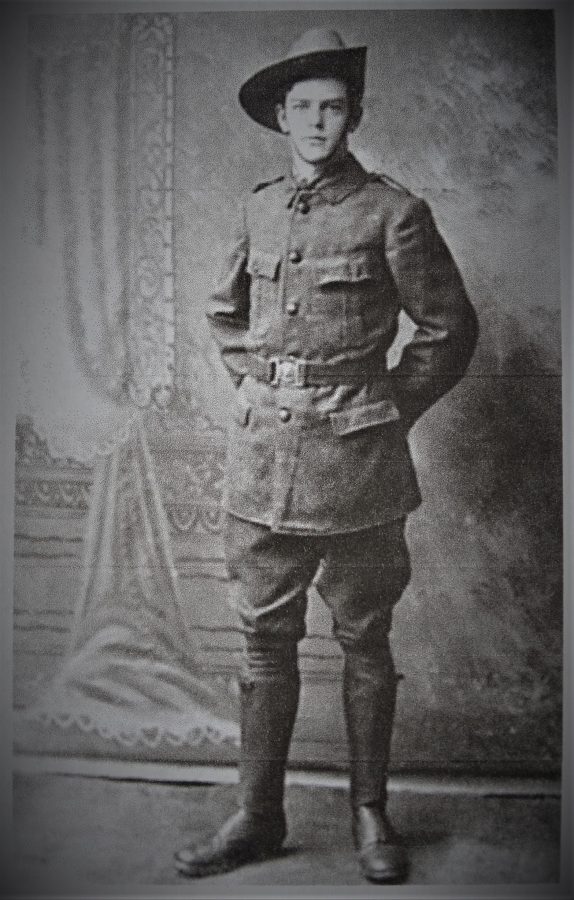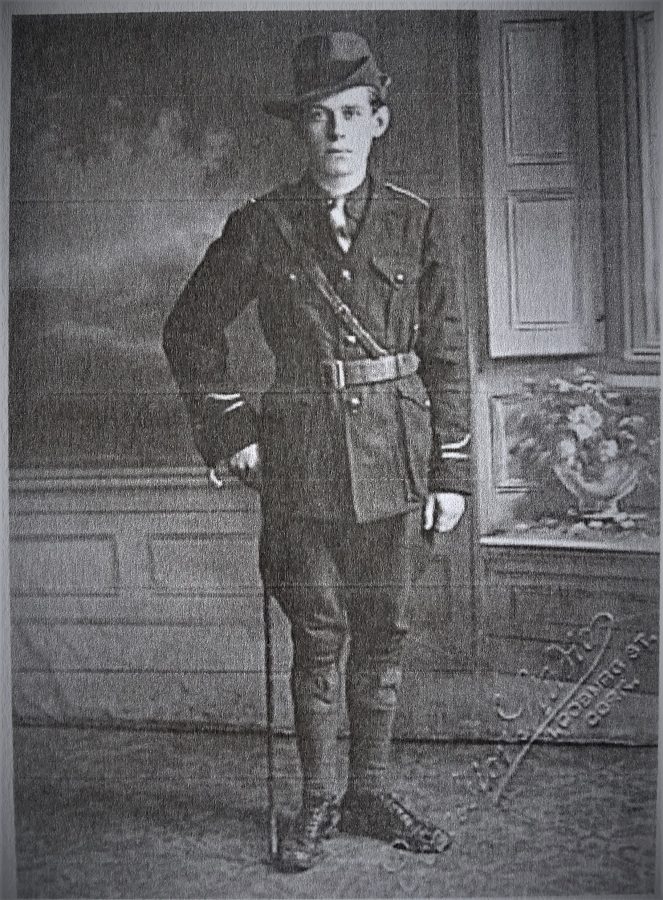
1058a. Cork Fianna member Christopher Lucey, 1916 (source: Cork City Library).
Kieran’s Our City, Our Town Article,
Cork Independent, 23 July 2020
Remembering 1920: Stories of the Fianna
The youth division of the Cork No.1 IRA Brigade or the Fianna was significant in their reconnaissance during 1920. It was in 1910 that the Na Fianna Éireann was established in Cork by republicans involved in the O’Growney Branch of the Gaelic League.
Charles Meaney, in his witness statement (WS1631), held in the Bureau of Military Archives describes his involvement. Charles joined the Fianna in Cork prior to the Easter Rising of 1916. He was about fifteen years old when he witnessed several other young Fianna teenagers leaving the city for Macroom with the Volunteers on Easter Sunday 1916. He was not allowed to go with them as he was considered to be too young. After 1916, his group kept together and, later that year, the Fianna was divided into two companies, or sluaghs, as they were known – one for the portion of the city north of the River Lee, and, one for the area south of the river. There were circa 60 teenagers in the organisation at that time, but their number increased subsequently to about 100 on the rolls.
The Fianna headquarters varied from time to time. They met in An Grianán, Queen Street, now Fr Mathew Street, Cork, a room in South Main Street Cork, in Drummy’s premises, Pope’s Quay, and in McGurk’s in North Main Street.
During 1917 and 1918, Fianna activities comprised drilling, general training of a military nature, lectures in first aid and rifle and revolver shooting. During the general election of December 1918, the Fianna were very active in distributing election literature for Sinn Féin, posting bills (sometimes at night during curfew).
Early in the year 1919 when, due to increasing numbers, it was decided to form three sluaghs in Cork city. These were known as the North Sluagh, Centre Sluagh and South Sluagh. There would be on an average of from 30 to 40 boys in each sluagh. The Fianna wore a uniform consisting of a blue short pants, green shirt, saffron scarf and green slouch hat. Fianna officers wore Sam Browne belts. When engaged on route marches they always wore the latter uniform, notwithstanding the ban placed on the wearing of military uniforms by the British forces.
Charles Meaney describes that during the years 1920-21, the really active members of the Fianna in Cork numbered not more than 30 and not all of these were armed. The use of arms by the Fianna in Cork was frowned on by the IRA leaders in the city, possibly it was thought that they were too young and irresponsible. An order was issued in 1920 from the IRA in Cork forbidding the Fianna to use arms unless with the prior permission of the local brigade company leaders.
According to Charles’s account, the activities of the Cork Fianna during 1920-1921 were varied. Raids were carried out at night on the houses of pro-British people who were suspected of having guns. Three or four of them usually carried out these raids with only one of the Fianna being armed with a revolver.
Many times the Fianna were called on to act as scouts for IRA units waiting in ambush. Their job was to give warning of the approach of enemy forces. Military and police barracks were watched and movements of troops, Black and Tans and RIC were duly reported to the IRA. Suspected spies were followed by them and their activity reported on. On several occasions too, they were called, at short notice, to remove guns and ammunition from IRA arms dumps in the city, which were in danger of discovery by the enemy.
The Cork Fianna frequently destroyed quantities of enemy stores being conveyed to barracks from shops in the city. Charles Meaney makes reference in his witness statement to a daylight hold-up of a lorry with provisions outside Dobbin’s shop in Alfred Street. Four or five of the were watching near Dobbins. When the lorry was loaded they got on to it and drove it to Hardwick Street where they emptied the contents (jam and other provisions) into a store. The goods were later distributed to the relatives of men in gaol.
When an order was made by Dáil Éireann that all goods from Belfast should be boycotted by shopkeepers, the Fianna in Cork were very active in enforcing the order. Many shops suspected of stocking goods from Belfast were visited, invoices examined and the proprietors warned not to sell such goods.
Attacks on individual members of the enemy forces were a feature of Fianna activities, 1920-21. Three or four of them waylaid soldiers and Black and Tans who were sometimes in the company of girls, or, perhaps, leaving a public house in a drunken condition. Whenever the opportunity offered, they attacked them, took their equipment and, in many cases got revolvers as well.
The carrying of IRA dispatches was part of the routine work of the Fianna, but nonetheless important. Boys were available at all times to carry out this work in co-operation with Cumann na mBan. P J Murphy in his witness statement (WS869) recalls his involvement in the Fianna and details that one of the most important dispatch houses for the IRA in Cork City and County was the Misses Wallace’s news agency shop in Brunswick Street, a small and narrow street at the back of St Augustine’s Chapel.
Towards the end of July 1920, information was received that the shop was to be raided by the British just before curfew hour which was 10pm. An ambushing party was detailed to cover both entrances to the street, P J Murphy was detailed by the Brigade Officer in Command (then Seán Hegarty) to remain outside the shop and give warning of the enemy’s approach. At the same time his job was to ensure that the clerk of the Chapel would not close the side entrance to the Chapel as this was their only means of escape, if the enemy used both entrances to the street. This detail was carried out for three consecutive nights and had no sooner withdrawn the third night when the place was raided. No arrests were made.
As the summer of 1920 progressed clashes between civilians, the RIC and Black and Tans became frequent, and often with fatal results.
Kieran’s new book Witness to Murder, The Inquest of Tomás MacCurtain is now available to purchase online (co-authored with John O’Mahony 2020, Irish Examiner/www.examiner.ie).
Captions:
1058a. Cork Fianna member Christopher Lucey, 1916 (source: Cork City Library).
1058b. Cork Fianna member Seamus Quirke, 1920 (source: Cork City Library).

1058b. Cork Fianna member Seamus Quirke, 1920 (source: Cork City Library).